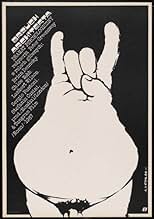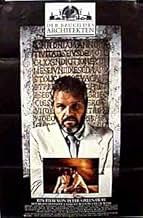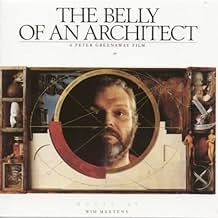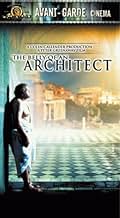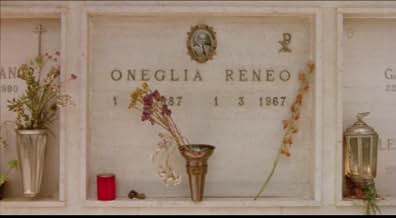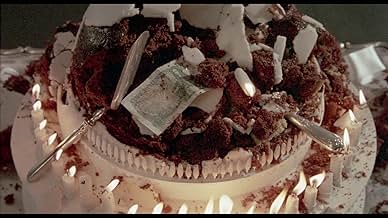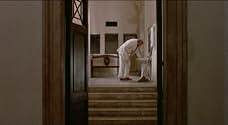IMDb-BEWERTUNG
6,9/10
6565
IHRE BEWERTUNG
Füge eine Handlung in deiner Sprache hinzuAn architect supervising an exhibition starts to have mysterious stomach pains while his life slowly falls apart.An architect supervising an exhibition starts to have mysterious stomach pains while his life slowly falls apart.An architect supervising an exhibition starts to have mysterious stomach pains while his life slowly falls apart.
- Auszeichnungen
- 2 Nominierungen insgesamt
Marino Masé
- Trettorio
- (as Marino Mase)
Empfohlene Bewertungen
An American architect (Dennehy) comes to Rome with his wife to create an exhibition he's been working on for 10years. He is troubled though by a terrible pain in his stomach.
Like all Greenaway's projects, this is decidedly off kilter - though not as much as usual - with his usual structured picture framing and colour (red and green) and fabulous use of music. The wonderful soundtrack here is not by Nyman, but is very similar.
Dennehy is perfect in the lead role, but Chloe Webb as his wife puts in a rather strange stilted performance as his wife.
This starts slow but improves as it goes along as Dennehy's story unfolds. Not for everyone, but lovers of the great director will enjoy this, even if it is more orthodox than usual.
Like all Greenaway's projects, this is decidedly off kilter - though not as much as usual - with his usual structured picture framing and colour (red and green) and fabulous use of music. The wonderful soundtrack here is not by Nyman, but is very similar.
Dennehy is perfect in the lead role, but Chloe Webb as his wife puts in a rather strange stilted performance as his wife.
This starts slow but improves as it goes along as Dennehy's story unfolds. Not for everyone, but lovers of the great director will enjoy this, even if it is more orthodox than usual.
One of my favorite Greenaway films. Story, visuals, metaphor, acting, music...it's got it all. The visuals of Rome are stunning. Wim Mertens' musical accompaniment is brilliant and on par with any modern minimalist composition. After years of seeing his TV roles, I was completely floored by the depth and authenticity Brian Dennehey brought to the main character. I've watched this film at least a dozen times over the years and enjoy it thoroughly each time. Unlike a previous reviewer, I don't see the need to judge this film based on how much it resembles previous or subsequent Greenaway films. "Belly of An Architect" is not as abstract as some of the other Greenaway films, but that shouldn't be viewed as a negative. The film is great and rich in its own right. I highly recommend it.
Why was this film made? Because someone talked Greenaway into trying to go mainstream. By this time, he had already made some of the most adventuresome films in history. This simple confection is sandwiched between `Zed and Two Noughts' and `Drowning by Numbers,' both of which are complex, intelligent, risky, erudite.
I can only imagine that he thought he could finance his serious work with a commercial success. Some might tag this as an accessible Greenaway film, but I hardly think it is Greenaway at all. Nor is the remarkable composer Nyman present.
All that remains are some lush compositions, studies in photographing monumental architecture, and these are pleasant enough. A subtext is fascist perfidy in architecture and the film takes a critical (visual) stance on Roman architecture. See here how all the buildings are from the emperors or Mussolini. No church architecture here which must have been a conscious omission for simplicity.
Everything about the physical fabric portrayed is dehumanizing, especially as compared to the containing space of the skin. As an architect myself, I can appreciate the message. It is a clever conceit, but it pales, utterly fades away, in comparison to his best: `The Falls,' and the `book' films.
I can only imagine that he thought he could finance his serious work with a commercial success. Some might tag this as an accessible Greenaway film, but I hardly think it is Greenaway at all. Nor is the remarkable composer Nyman present.
All that remains are some lush compositions, studies in photographing monumental architecture, and these are pleasant enough. A subtext is fascist perfidy in architecture and the film takes a critical (visual) stance on Roman architecture. See here how all the buildings are from the emperors or Mussolini. No church architecture here which must have been a conscious omission for simplicity.
Everything about the physical fabric portrayed is dehumanizing, especially as compared to the containing space of the skin. As an architect myself, I can appreciate the message. It is a clever conceit, but it pales, utterly fades away, in comparison to his best: `The Falls,' and the `book' films.
Greenaway's visuals (which betray his origins as a painter in almost every gorgeously composed shot) are sumptuous. Wim Mertens score is mesmerizing. Add them to Brian Dennehy's towering performance as obsessed, betrayed, and ultimately dying American architect Stourley Kracklite and you have something very special. Kracklite is in Rome battling to put on an exhibition to his idol, 18th century French architect Etienne Louis Boulet. His young wife (Webb) betrays him, the natives scheme to undermine his exhibition and he begins to crumble physically like the ruins of the eternal city around him. The story, largely carried on Dennehy's massive shoulders, is almost incidental to the glorious, poetic footage of Rome. It is so movingly beautiful that, when I finally got around to visiting the city (a trip in no small part inspired by this film) the reality of the place couldn't compete. If you can, watch this on a big screen with the best possible suround-sound. If you can't, watch it anyway.
The ebullient Brian Dennehy gives a fine performance as Stourley Kracklite, an American architect who is in Rome with his younger wife Louisa (Chloe Webb) to arrange an exhibition on the French architect Etienne-Louis Boullée. Kracklite is obsessed with Boullée and even writes letters to him. Kracklite's life soon begins to deteriorate. He starts to suffer excruciating stomach pains and vomits each time he eats. He even thinks that his wife is poisoning him. His wife then falls pregnant and has an affair with Kracklite's rival architect, Caspasian Speckler (Lambert Wilson). Kracklite then sleeps with Speckler's sister, to get some sort of satisfaction. Speckler intrudes while they are having sex, and announces, "having sex with your pregnant wife is perfect, because I don't need to use contraception". Kracklite then punches him on the nose. Speckler's sister then says, "Don't put your blood on my white towel."
The film follows the parallels of these two unappreciated architects from different eras. The film is memorable for Dennehy's (an actor who is also unappreciated) remarkable performance. Also, the beautiful cinematography by Greenaway's trusty DOP Sacha Vierny makes the film very easy to look at. From the ancient architecture of Rome, to a painting-like bowl of figs, it is pristine-looking. Michael Nyman is absent, but the music by Wim Mertens is splendid. This film was made in between A Zed & Two Noughts and Drowning by Numbers, and it is quite unlike those two films, which, I think, are superior to this in the way they offer us a much more enigmatic, abstract concept. But even an ever so slightly lesser Greenaway film is a thing to behold.
The film follows the parallels of these two unappreciated architects from different eras. The film is memorable for Dennehy's (an actor who is also unappreciated) remarkable performance. Also, the beautiful cinematography by Greenaway's trusty DOP Sacha Vierny makes the film very easy to look at. From the ancient architecture of Rome, to a painting-like bowl of figs, it is pristine-looking. Michael Nyman is absent, but the music by Wim Mertens is splendid. This film was made in between A Zed & Two Noughts and Drowning by Numbers, and it is quite unlike those two films, which, I think, are superior to this in the way they offer us a much more enigmatic, abstract concept. But even an ever so slightly lesser Greenaway film is a thing to behold.
Wusstest du schon
- WissenswertesBrian Dennehy was quoted after the release as saying "I've made lots of movies but this is my first film."
- PatzerWhen photocopying the picture of Augustus, Kracklite puts the picture in upside-down which would have given a blank copy. Additionally, it would not be possible to achieve the level of resolution of Augustus's abdomen from such a small picture.
- Zitate
Caspasian Speckler: Your wife is very beautiful, Signor Kracklite, especially when she is pregnant.
Stourley Kracklite: Yes, that's right. She is pregnant. But not with your child, Speckler.
Caspasian Speckler: True. I'm very grateful to you for that. Your child, shall we say, is the most perfect contraceptive.
[Kracklite turns and punches Speckler in the nose]
- VerbindungenFeatured in Peter Greenaway (1992)
Top-Auswahl
Melde dich zum Bewerten an und greife auf die Watchlist für personalisierte Empfehlungen zu.
- How long is The Belly of an Architect?Powered by Alexa
Details
- Erscheinungsdatum
- Herkunftsländer
- Sprachen
- Auch bekannt als
- The Belly of an Architect
- Drehorte
- Produktionsfirmen
- Weitere beteiligte Unternehmen bei IMDbPro anzeigen
Box Office
- Bruttoertrag in den USA und Kanada
- 287.725 $
- Laufzeit
- 1 Std. 59 Min.(119 min)
- Farbe
- Sound-Mix
- Seitenverhältnis
- 1.85 : 1
Zu dieser Seite beitragen
Bearbeitung vorschlagen oder fehlenden Inhalt hinzufügen


